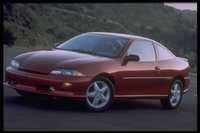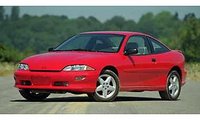1996 Cheverolet Cavalier Review
SEE ALSO: Chevrolet Buyer's Guide
By Ted Laturnus
When Canadians go tire-kicking, we tend to want maximum bang for the buck without spending much for it. Without putting too fine a point on it, we are stingy with our car-buying dollars.
Thus it comes as no surprise that best-selling passenger car in Canada for at least the past seven years has been the Chev Cavalier. Among the most affordable sub-compact sedans sold in Canada, the Cavalier is the lowest priced car that comes with anti-locking brakes and dual airbags as standard equipment. Both the Cavalier and its kissing cousin, the Pontiac Sunfire, seat five, and still start at under $15,000, differing chiefly in exterior appearance.
The Cavalier can trace its beginnings back to the early 1980s. Like the Ford Escort, it was a direct response by the domestic car industry to the challenge being posed by well-made and affordable sub-compacts from Japan, such as the Honda Civic, Toyota Corolla, and Mazda GLC. It debuted in late 1981 as a 1982 model, and, aside from engineering changes and refinements, remained essentially the same until 1994, when it received a complete overhaul and makeover for 1995.
Base powerplant for the Cavalier has always been an overhead valve (OHV) four cylinder engine that has varied in size from 2 litres to 2.2. While not the most elegant of four-bangers, this powerplant has proven to be fairly durable and easily serviced. Horsepower output varies from 110, up to 115 for the current model. Transmission choices have always been straightforward: five-speed manual or three-speed automatic. GM introduced a German-made Getrag five-speed manual gearbox in 1987, and a four-speed automatic in 1996. Prospective Cavalier buyers are advised to eschew the four-cylinder/autobox combination; there simply isn’t enough oomph in the four to propel this 1130 kilogram (2490 lb.) sedan with any kind of authority. This is especially true with the three-speed autobox. GM offered their 2.8 litre V6 with the Cavalier/Pontiac Sunbird in 1985, which helped things along, later increasing it in size to 3.1 litres, in 1993. In 1995, they also offered an optional 2.3 litre overhead cam engine, when the current generation of Cavalier was introduced.
While the value leader of the Cavalier has always been the two-door coupe, GM has offered a pretty wide range of body styles: four-door sedan, two-door convertible, and four-door station wagon (discontinued after 1994). There have also been odd and sundry variations such as the “sporty” Z24 coupe and RS and VL models. The difference between these last two is unclear; both qualify as base models, and differ only in cosmetics.
Over the years, the Cavalier has posted some pretty impressive sales figures, peaking at a remarkable 431,000 total for all of North America, in 1985. Fleet sales are a big reason for these numbers and for awhile there, it seemed like every rental company, municipal corporation, and multi-national conglomerate had a huge flotilla of Cavaliers awaiting our pleasure in their yards. That hasn’t changed much, and lease/rentals remain a major factor in the success of the Cavalier.
It’s also difficult to come up with another entry-level car that can match the Cavalier’s dazzling transformation, in 1994. From a rather frumpy and unexciting econobox with mediocre power, agricultural road manners, and yawn-inducing styling, it evolved seemingly overnight into a stylish, well-assembled and fun to drive sedan that almost deserves to have the word “sports” in front of it. The differences between the former and current generations of Cavalier are nothing short of amazing. The current generation is more comfortable, quieter, better looking, roomier, and doesn’t convey that ineffable sense of cheapness that afflicted the first generation. If you bought a pre-1995 Cavalier, you did so because of budgetary considerations, and driving one, you felt like you were behind the wheel of an economy car, which, of course, you are. This is not the case with the newer version. People buy it not just because it’s cheap, but because they actually want to buy it. The fact that it does have an accessible price tag is something of a bonus. Another good feature is the size of the trunk. At 374 litres (13.2 cubic feet), it’s the largest in this class. The sedan and coupe have identically-sized trunks, incidentally.
Since 1995, the Cavalier has also compiled a pretty decent record for assembly quality and recalls. The older version was, shall we say, problematic in some areas, notably braking, safety, and electrical systems, and has been recalled at least once by Transport Canada every year from 1989 onward. The Canadian Automobile Association charts pre-1994 Cavalier/Sunbirds as having “much worse than average” cooling systems, fuel system, suspensions, and body assembly. Particularly the 1992 model, which does not fare very well at all in their frequency of repair surveys. On the other hand, degree of customer satisfaction with the Cavalier is set at almost 75 per cent, so it can’t be all bad, And, let’s face it, any vehicle sold in such vast numbers is bound to have some contretemps.
If the older Cavalier was troublesome, the new model has been a paragon of reliability, customer satisfaction, and assembly quality. In virtually every study conducted, it has come out smelling like a rose. Even those hard-to-please curmudgeons at Lemon Aid rate the new Cavalier as an “above average buy”, with reasonably priced parts and service and better than average overall reliability. About the only fly in the ointment is the optional twin cam Quad Four engine, which comes with the Z24 and was increased in size to 2.4 litres and 150 horses in 1997. This engine has a history of being one of the most troublesome powerplants ever manufactured by GM, and has been used, with little success, throughout their lineup.
I would add that both the Quad Four and the standard issue 2.2 engines are pretty buzzy at highway speed and NVH (noise and vibration harshness) ain’t what it could be. I also have trouble with lack of headroom, especially in the two-door version, and I have heard some rumblings of discontent regarding the convertible version, which hit the market halfway through the 1995 model year. Apparently, it's prone to leakage. The Z24 version, meanwhile, also debuted halfway through 1995, and has suspension upgrades, larger wheels and tires, and a five-speed manual transmission as standard issue. Curiously, it retains the front disc/rear drum brake setup of its sedan counterpart, and does not have four-wheel discs. Perhaps it should have. I think that the V6 engine would be a better choice for this car than the questionable Quad Four.
The Cavalier is a pretty frugal car to operate. As well as having “reasonably” priced parts, it gets decent fuel economy. The manual transmission, 2.2 litre version will return 10.1 L/100 km (28 mpg) in the city, and 6.1 L/100 km (46 mpg) on the highway, according to Transport Canada. I suspect these numbers would improve as the car gets a few kilometres on it.




